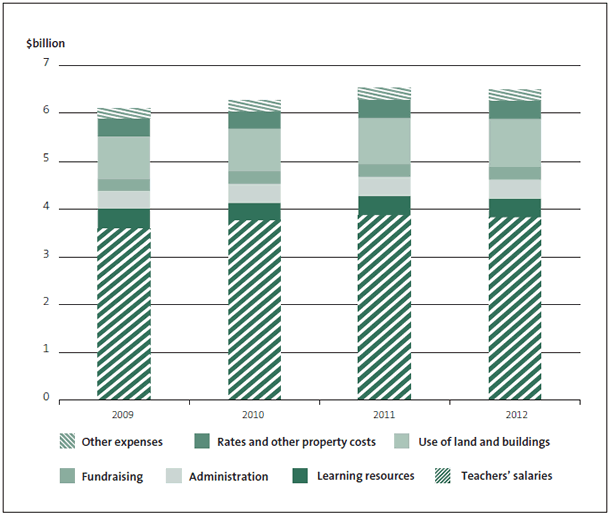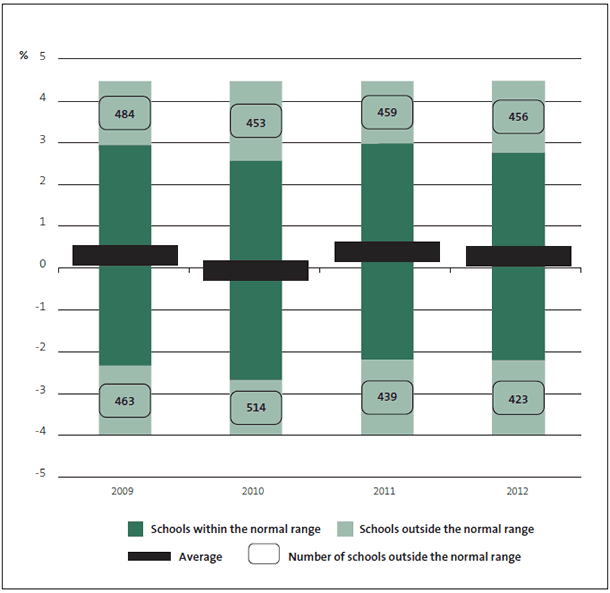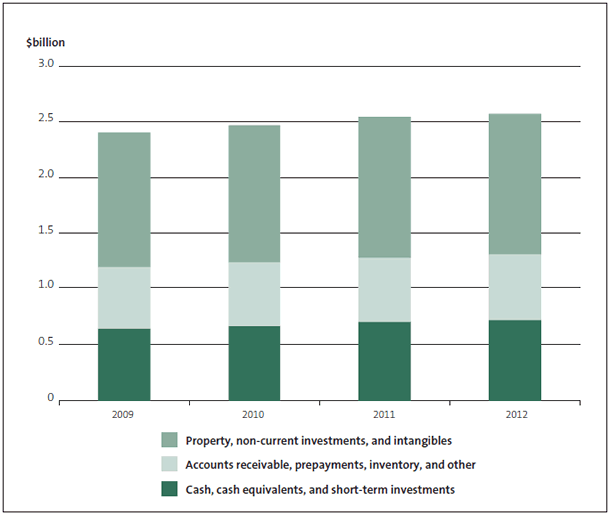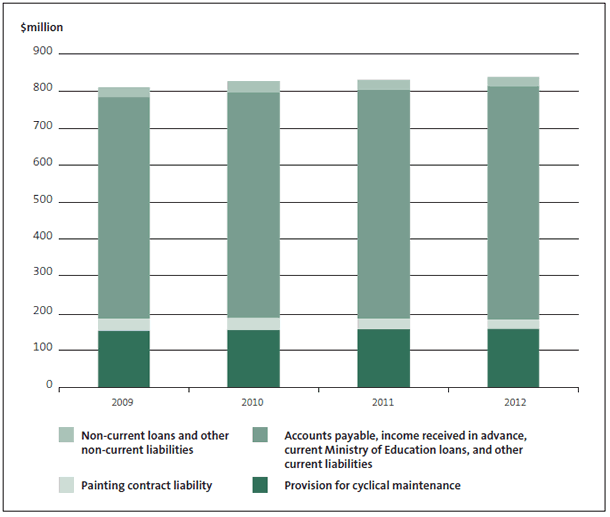Part 4: Financial health of schools
4.1
The financial health of schools is a matter of significant public interest. In this report, we provide an overview of the financial health of schools as a whole. We do not comment on the financial health of individual schools.
4.2
Boards are responsible under section 75 of the Education Act for managing, organising, and administering state schools. This has been the case since the education reforms of the late 1980s and early 1990s.
4.3
The Government largely funds schools through operational grants, teachers' salaries grants, and other grants. Also, schools typically raise funds ("locally raised funds") within their local communities. Some schools generate revenue from other sources, such as through operating hostels or enrolling international students.
4.4
Boards have significant discretion in how to spend their operational grant funding, whereas the Ministry pays teachers' salaries on behalf of schools. Funding for teachers' salaries is based on staffing entitlements that the Ministry works out using school roll data.
4.5
The Crown owns most land and buildings that state schools use. The proprietors own the land and buildings of state-integrated schools. Most land and buildings that state schools use are not recorded as assets in schools' financial statements.
4.6
The Ministry provides funding for major capital works in state schools. The proprietors pay for major capital works in state-integrated schools. Some schools own buildings that they have wholly or largely funded, with the Ministry's approval.
4.7
Schools are expected to maintain the buildings that they use through regular and cyclical maintenance programmes. Cyclical maintenance, such as periodic painting of school buildings, has a pattern of recurrence spanning several years. Funding to cover this maintenance is included in the operational grants that each school receives.
4.8
The decision on whether a school should continue to exist is driven mainly by educational, not financial, factors. If the Ministry considers that a school is needed in a particular location, it is likely to continue to support the school financially and, if necessary, by statutory management. If the Ministry considers that a school is no longer needed in a particular location, the financial health of the school is unlikely to be a deciding factor.
Financial profile of schools
4.9
Section 87B of the Education Act requires the Minister of Education to prepare and present a report on the performance of schools to the House of Representatives every year. In preparing this Part, we drew from the Minister's 2012 report – New Zealand Schools Ngā Kura o Aotearoa: A report on the compulsory schools sector in New Zealand – 2012.3 We have also used more recent information from the audited financial statements that the Ministry collects each year from all schools. When the relevant 2012 information is not yet in the Ministry's database, we have used 2011 data instead.
4.10
In the graphs in this Part, we have used information from audited financial statements of schools covering the period from 2009 to 2012.4
4.11
The Government provided slightly more than 88% of schools' revenue in each of the years 2009 to 2012 (see Figures 4 and 5). Locally raised funds are the next most significant source of schools' revenue (about 7% of total revenue).
Figure 4
Sources of school revenue, 2009-2012
| Revenue | 2009 | 2010 | 2011 | 2012 (est) |
|---|---|---|---|---|
| $000 | $000 | $000 | $000 | |
| Government grants | 5,446,245 | 5,562,574 | 5,840,535 | 5,898,163 |
| Locally raised funds | 474,809 | 473,484 | 477,480 | 487,535 |
| International students | 99,210 | 105,125 | 110,770 | 108,133 |
| Investments | 36,450 | 39,168 | 39,596 | 38,668 |
| Hostels | 30,140 | 30,261 | 32,540 | 33,441 |
| Other revenue | 70,981 | 104,838 | 112,852 | 108,690 |
| Total revenue | 6,157,835 | 6,315,450 | 6,613,773 | 6,674,630 |
| Proportion of government funding | 88.4% | 88.1% | 88.3% | 88.4% |
Notes: Based on New Zealand Schools Ngā Kura o Aotearoa: A report on the compulsory schools sector in New Zealand – 2012, page 25, Table 1 School revenue, 2009-2012. Figures are GST exclusive, rounded, and include grants from the Government and proprietors for the use of land and buildings. Figures for 2012 are estimates based on 1942 (80% of) schools at the time the report was prepared (September 2013) and estimates based on previous accounts data for the remaining schools.
Figure 5
Schools' total revenue by source, 2009-2012

4.12
Our analysis confirms the significance to schools of Crown funding, which contributed to an increase of 8.4% in schools' annual revenue between 2009 and 2012.
4.13
Schools' most significant expenses are salaries (of teaching and non-teaching staff), and the notional rent that the Ministry charges for the use of Crown-owned land and buildings (see Figure 6).
Figure 6
Schools' total expenditure by type, 2009-2012

4.14
Between 2009 and 2012, schools' annual expenses increased by 8.3%, slightly less than the increase in revenue during the same period.
4.15
One of the main measures of a school's financial health is its financial performance during the year. The operating position is important because it helps us to understand whether a school is operating within its means. This is shown by the operating surplus or deficit (whether it spends more than its revenue). In any year, many schools spend slightly less than their revenue and others spend slightly more. This is inevitable and not a concern.
4.16
Schools achieved a combined operating surplus of 0.5% of total revenue in 2012, slightly less than the 0.6% in 2011. Figure 7 shows that about half of the country's schools reported an operating surplus in the years 2010-2012.
Figure 7
Percentage of schools with an operating surplus, 2010-2012
| All schools (%) | Primary schools (%) | Secondary schools (%) | Other schools (%) | |
|---|---|---|---|---|
| 2010 | 49.2 | 48.2 | 52.9 | 56.5 |
| 2011 | 56.3 | 55.3 | 59.6 | 71.1 |
| 2012 | 55.2 | 54.4 | 57.2 | 72.5 |
Based on New Zealand Schools Ngā Kura o Aotearoa: A report on the compulsory schools sector in New Zealand – 2012, page 27, Table 3 Percentage of schools with an operating surplus 2010-2012.
4.17
Schools that recorded an operating surplus and schools that recorded an operating deficit are relatively evenly distributed, as shown in Figure 8.
Figure 8
Schools' net surpluses and deficits as percentage of total revenue, 2009-2012

4.18
In Figure 8, "the normal range" is one standard deviation either side of the average. The schools outside that range with positive values had a surplus to total revenue percentage that was more than one standard deviation better than the average. The schools outside that range with negative values had recorded deficits that put their deficit to total revenue more than one standard deviation below the average.
4.19
Another measure of the financial health of a school is its financial position at the end of the year. Within that overall financial position is the working capital surplus/deficit – whether current assets exceed current liabilities and, therefore, whether short-term debts can be paid as they fall due. Schools tend to receive funding, such as for maintenance of buildings, in advance, so a working capital surplus is expected to be the norm.
4.20
Figure 9 shows that more than 90% of all schools had a working capital surplus at the end of 2012.
Figure 9
Percentage of schools in different working capital ratio bands, 2012
| Working capital ratio | All schools (%) | Primary schools (%) | Secondary schools (%) | Other schools (%) |
|---|---|---|---|---|
| Under 1.0 | 6.2 | 4.9 | 12.8 | 0 |
| 1.0 to 2.0 | 41.6 | 38.7 | 56.7 | 17.5 |
| 2.0 to 3.0 | 26.8 | 28.7 | 17.3 | 37.5 |
| More than 3.0 | 25.4 | 27.7 | 13.2 | 45.0 |
Note: Based on New Zealand Schools Ngā Kura o Aotearoa: A report on the compulsory schools sector in New Zealand – 2012, page 27 Table 4 Percentage of schools in different working capital ratio bands, 2012. A working capital ratio of more than 1.0 is a working capital surplus, meaning current assets exceed current liabilities.
4.21
Figure 10 shows that the value of schools' total assets grew steadily between 2009 and 2012.
Figure 10
Total value of schools' assets, 2009-2012

Note: Excludes school land and buildings owned by the Crown.
4.22
Schools' assets are about three times larger than their liabilities. Net assets, the difference between total assets and total liabilities, is also an indicator of financial health. Schools' total liabilities have not increased as quickly as total assets (see Figure 11), meaning that schools' net assets (or public equity) increased between 2009 and 2012.
Figure 11
Schools' liabilities, 2009-2012

4.23
Figure 12 shows the increasing value of net assets of schools between 2010 and 2012.
Figure 12
Growth in schools' net assets, 2010-2012
| All schools $000 | Primary schools $000 | Secondary schools $000 | Other schools $000 | |
|---|---|---|---|---|
| 2010 | 1,653,381 | 894,709 | 705,854 | 52,818 |
| 2011 | 1,723,981 | 920,329 | 747,627 | 56,025 |
| 2012 | 1,761,579 | 939,814 | 763,789 | 57,976 |
Note: Based on New Zealand Schools Ngā Kura o Aotearoa: A report on the compulsory schools sector in New Zealand – 2012, page 28. Table 5 Public equity trends ($) 2010-2012
4.24
The ratio of net assets to total assets in schools has been slightly less than 0.7 in each of the years 2009 to 2012 (see Figure 13), indicating a strong balance sheet for schools as a whole.
Figure 13
Schools' net assets as a percentage of total assets, 2009-2012

4.25
In Figure 13, "the normal range" is one standard deviation either side of the average. The schools outside that range and above the average have a particularly strong financial position. The schools outside that range and below the average have a relatively weaker financial position.
Concluding comments about the financial health of schools
4.26
Using financial information that the Ministry has collected, we can draw some conclusions about the financial health of schools as a whole.
4.27
We have reviewed information on revenue and expenditure, the operating surplus/deficit, working capital, assets, liabilities and net assets/public equity.
4.28
The financial health of schools as a whole appears to be relatively sound, with:
- a high proportion of revenue from crown funding;
- a high average working capital ratio – about 50% of schools have more than $2 of current assets for every dollar of current liabilities; and
- high average net assets (public equity) of nearly 70% of total assets.
4.29
However, the financial profile of schools, as shown in the figures in this Part, indicates that some schools are not in such a sound financial position as schools as a whole.
3: This report is available on the Ministry of Education's Education Counts website at www.educationcounts.govt.nz.
4: This information comes from the Ministry of Education's database of schools' financial statements as at December 2013. By December 2013, about 92% of the results of schools audits for 2012 had been entered into the database. For the remaining schools, the 2011 financial statement data was used as a proxy for 2012.
5: New Zealand Schools Ngā Kura o Aotearoa: A report on the compulsory schools sector in New Zealand – 2012, page 27.

